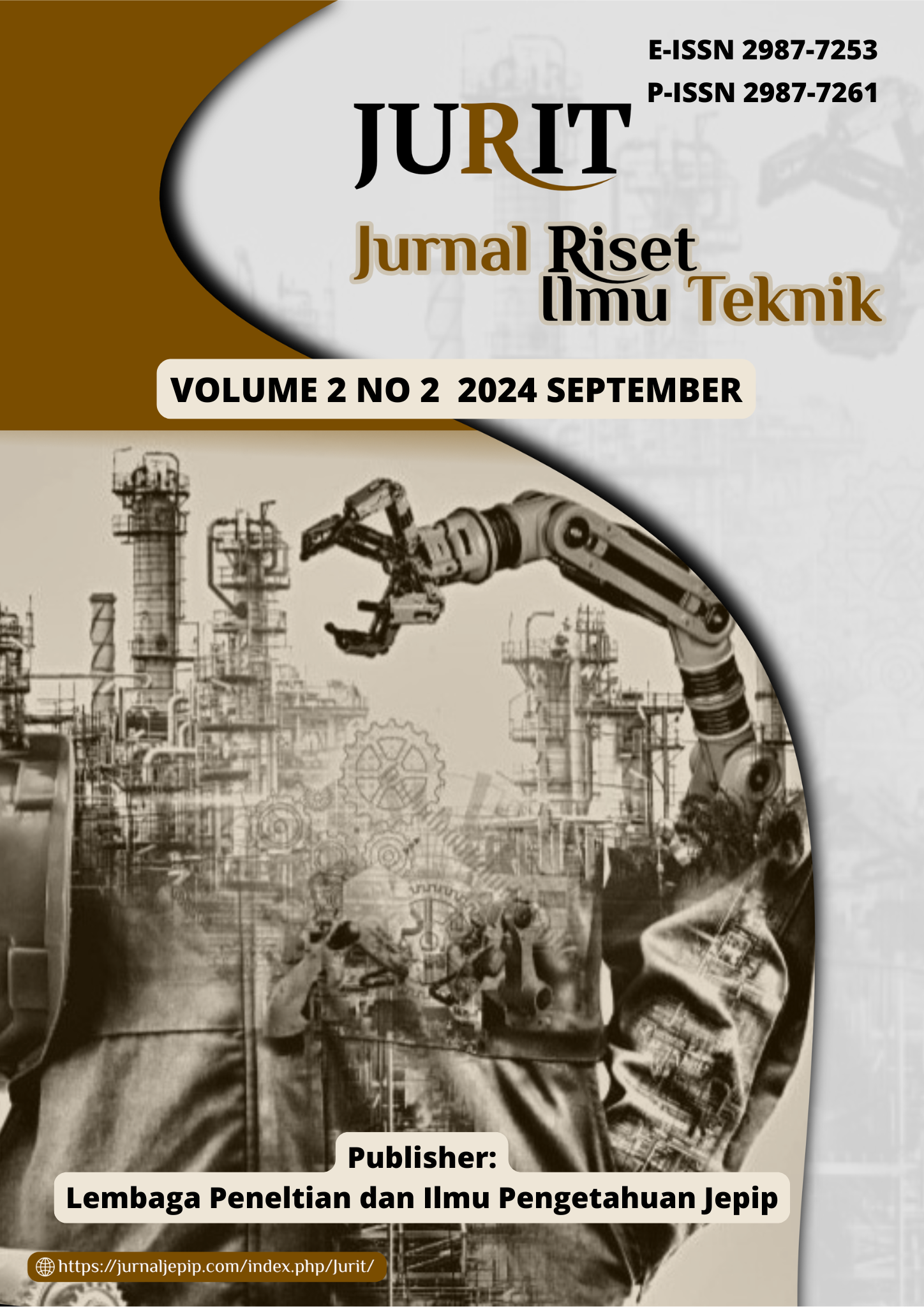A Hybrid Six Sigma Dmaic and Fuzzy-FMEA Framework For Defect Reduction and Quality Enhancement In White Copra Production
DOI:
https://doi.org/10.59976/jurit.v2i2.113Keywords:
Six Sigma, Fuzzy-FMEA, White Copra, Product Quality, AgroindustryAbstract
T
This study aims to analyze the factors causing defects in white copra products using the Six Sigma (DMAIC) method integrated with Fuzzy-Failure Mode and Effect Analysis (Fuzzy-FMEA). The research method includes collecting production data, calculating Defects Per Million Opportunities (DPMO), determining the sigma level, and analyzing the root causes through cause-and-effect diagrams and risk assessment using Fuzzy-FMEA. The results show that the average sigma level of the process is at 3.63 with a DPMO value of 16,910, indicating that process performance still needs improvement. The dominant factors causing defects include unstable drying temperature, storage humidity, oven machine damage, and operator skill variation. The highest priority risks identified were drying temperature and humidity control, which directly impact the quality of the final product. The practical implications of this study are the need to implement mechanical drying with automatic temperature control, operator training programs, preventive oven maintenance, and standard operating procedures (SOPs) in quality control. This study contributes to strengthening empirical evidence of the application of DMAIC combined with Fuzzy-FMEA in agroindustry, particularly in coconut processing, and serves as a reference for improving product quality based on a quantitative and fuzzy logic approach.
References
A. Devi, “Haematology, carcass and fatty acid composition of finishing broilers fed enzyme supplemented expeller copra meal in corn-animal protein diets,” Rev. Bras. Cienc. Avic. Brazilian J. Poult. Sci., vol. 22, no. 2, pp. 1–8, 2020, doi: 10.1590/1806-9061-2019-1126.
M. Apriyanto, “Innovative Techniques for High-Quality White Copra Production: The Role of Sulfur Smoke and Kubung Dryers,” 2024. doi: 10.1051/e3sconf/202459303003.
T. Qiao, “Analysis on genetic variation and differentiation of Tyrophagus putrescentiae in different geographic populations,” Chinese J. Parasitol. Parasit. Dis., vol. 42, no. 1, pp. 69–77, 2024, doi: 10.12140/j.issn.1000-7423.2024.01.010.
A. Niñerola, “Quality improvement in healthcare: Six Sigma systematic review,” 2020. doi: 10.1016/j.healthpol.2020.01.002.
H. M. Alzoubi, “Investigating the impact of total quality management practices and Six Sigma processes to enhance the quality and reduce the cost of quality: the case of Dubai,” Int. J. Bus. Excell., vol. 27, no. 1, pp. 94–109, 2022, doi: 10.1504/IJBEX.2022.123036.
H. Yang, “Six-Sigma Quality Management of Additive Manufacturing,” 2021. doi: 10.1109/JPROC.2020.3034519.
A. M. Ponsiglione, “A six sigma DMAIC methodology as a support tool for health technology assessment of two antibiotics,” Math. Biosci. Eng., vol. 18, no. 4, pp. 3469–3490, 2021, doi: 10.3934/MBE.2021174.
Y. Ramakrishna, “Empirical Investigation of Mediating Role of Six Sigma Approach in Rationalizing the COQ in Service Organizations,” Oper. Supply Chain Manag., vol. 15, no. 1, pp. 122–135, 2022, doi: 10.31387/oscm0480335.
A. S. Sagayaraj, “Prediction of Sulfur Content in Copra Using Machine Learning Algorithm,” Appl. Artif. Intell., vol. 35, no. 15, pp. 2228–2245, 2021, doi: 10.1080/08839514.2021.1997214.
R. O. De Castro, “Concentrations of Digestible, Metabolizable, and Net Energy in Coconut Co-products Fed to Growing Pigs,” Philipp. Agric. Sci., vol. 105, no. 1, pp. 1–9, 2022, [Online]. Available: https://www.scopus.com/inward/record.uri?partnerID=HzOxMe3b&scp=85128740379&origin=inward
A. Josephrajkumar, “Pest dynamics and suppression strategies,” 2019. doi: 10.1007/978-981-13-2754-4_12.
R. Rahmawati, “Moringa oleifera leaf meal to substitute soybean meal increase the performance of Javanese thin-tailed ewes,” J. Adv. Vet. Res., vol. 14, no. 1, pp. 209–213, 2024, [Online]. Available: https://www.scopus.com/inward/record.uri?partnerID=HzOxMe3b&scp=85181926809&origin=inward
N. Al-Amin, “Carcass characteristics of male New Zealand white rabbits fed complete pellet containing different levels of leucaena leaf meal,” 2020. doi: 10.1088/1755-1315/425/1/012087.
L. Gaikwad, “An integrated Lean, Green and Six Sigma strategies: A systematic literature review and directions for future research,” TQM J., vol. 32, no. 2, pp. 201–225, 2020, doi: 10.1108/TQM-08-2018-0114.
R. Rathi, “Green Lean Six Sigma for improving manufacturing sustainability: Framework development and validation,” J. Clean. Prod., vol. 345, 2022, doi: 10.1016/j.jclepro.2022.131130.
V. Swarnakar, “Evaluating critical failure factors for implementing sustainable lean six sigma framework in manufacturing organization: A case experience,” Int. J. Lean Six Sigma, vol. 11, no. 6, pp. 1083–1118, 2020, doi: 10.1108/IJLSS-05-2019-0050.
L. B. M. Costa, “Lean six sigma in the food industry: Construct development and measurement validation,” Int. J. Prod. Econ., vol. 231, 2021, doi: 10.1016/j.ijpe.2020.107843.
V. Vaishnavi, “Modelling of readiness factors for the implementation of Lean Six Sigma in healthcare organizations,” Int. J. Lean Six Sigma, vol. 11, no. 4, pp. 597–633, 2020, doi: 10.1108/IJLSS-12-2017-0146.
M. Singh, “Analysis and prioritization of Lean Six Sigma enablers with environmental facets using best worst method: A case of Indian MSMEs,” J. Clean. Prod., vol. 279, 2021, doi: 10.1016/j.jclepro.2020.123592.
E. A. Cudney, “Systematic review of Lean and Six Sigma approaches in higher education,” Total Qual. Manag. Bus. Excell., vol. 31, no. 3, pp. 231–244, 2020, doi: 10.1080/14783363.2017.1422977.
S. M. Ali, “Barriers to lean six sigma implementation in the supply chain: An ISM model,” Comput. Ind. Eng., vol. 149, 2020, doi: 10.1016/j.cie.2020.106843.
H. Gholami, “The application of Green Lean Six Sigma,” Bus. Strateg. Environ., vol. 30, no. 4, pp. 1913–1931, 2021, doi: 10.1002/bse.2724.
M. S. Kaswan, “Green Lean Six Sigma for sustainable development: Integration and framework,” Environ. Impact Assess. Rev., vol. 83, 2020, doi: 10.1016/j.eiar.2020.106396.
B. Byrne, “Applying lean six sigma methodology to a pharmaceutical manufacturing facility: A case study,” Processes, vol. 9, no. 3, 2021, doi: 10.3390/pr9030550.
I. Daniyan, “Application of lean Six Sigma methodology using DMAIC approach for the improvement of bogie assembly process in the railcar industry,” Heliyon, vol. 8, no. 3, 2022, doi: 10.1016/j.heliyon.2022.e09043.
J. Antony, “The evolution and future of lean Six Sigma 4.0,” TQM J., vol. 35, no. 4, pp. 1030–1047, 2023, doi: 10.1108/TQM-04-2022-0135.
V. S. Bhat, “Simulation-based lean six sigma for Industry 4.0: an action research in the process industry,” Int. J. Qual. Reliab. Manag., vol. 38, no. 5, pp. 1215–1245, 2021, doi: 10.1108/IJQRM-05-2020-0167.
A. Scala, “Lean six sigma approach for reducing length of hospital stay for patients with femur fracture in a university hospital,” Int. J. Environ. Res. Public Health, vol. 18, no. 6, pp. 1–13, 2021, doi: 10.3390/ijerph18062843.
J. C. Sá, “A model of integration ISO 9001 with Lean six sigma and main benefits achieved,” Total Qual. Manag. Bus. Excell., vol. 33, no. 1, pp. 218–242, 2022, doi: 10.1080/14783363.2020.1829969.
A. S. Patel, “Critical review of literature on Lean Six Sigma methodology,” 2020. doi: 10.1108/IJLSS-04-2020-0043.
N. Yadav, “Impact of Industry4.0/ICTs, Lean Six Sigma and quality management systems on organisational performance,” TQM J., vol. 32, no. 4, pp. 815–835, 2020, doi: 10.1108/TQM-10-2019-0251.
S. Bhat, “Lean Six Sigma competitiveness for micro, small and medium enterprises (MSME): an action research in the Indian context,” TQM J., vol. 33, no. 2, pp. 379–406, 2021, doi: 10.1108/TQM-04-2020-0079.
A. Belhadi, “The integrated effect of Big Data Analytics, Lean Six Sigma and Green Manufacturing on the environmental performance of manufacturing companies: The case of North Africa,” J. Clean. Prod., vol. 252, 2020, doi: 10.1016/j.jclepro.2019.119903.
N. Yadav, “Critical success factors for lean six sigma in quality 4.0,” Int. J. Qual. Serv. Sci., vol. 13, no. 1, pp. 123–156, 2021, doi: 10.1108/IJQSS-06-2020-0099.
A. Farrukh, “A natural resource and institutional theory-based view of green-lean-six sigma drivers for environmental management,” Bus. Strateg. Environ., vol. 31, no. 3, pp. 1074–1090, 2022, doi: 10.1002/bse.2936.
S. Tissir, “Lean Six Sigma and Industry 4.0 combination: scoping review and perspectives,” 2023. doi: 10.1080/14783363.2022.2043740.
G. S. Hundal, “Lean Six Sigma as an organizational resilience mechanism in health care during the era of COVID-19,” Int. J. Lean Six Sigma, vol. 12, no. 4, pp. 762–783, 2020, doi: 10.1108/IJLSS-11-2020-0204.
M. Singh, “Lean Six Sigma Project Selection in a Manufacturing Environment Using Hybrid Methodology Based on Intuitionistic Fuzzy MADM Approach,” IEEE Trans. Eng. Manag., vol. 70, no. 2, pp. 590–604, 2023, doi: 10.1109/TEM.2021.3049877.
Downloads
Published
How to Cite
Issue
Section
License
Copyright (c) 2024 Fatiyah Azzahra, M. Afiq Aznan

This work is licensed under a Creative Commons Attribution 4.0 International License.





















